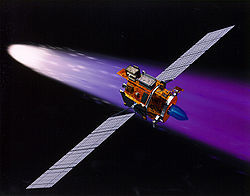Wikijunior:Future/10 years into the future

Imagine you are 10 years into the future.
The year is now 2035. The world has changed quite a bit, but it's still easily recognizable from a look at a map, or, as the case will be, the computer.
Computers
[edit | edit source]
Computers have advanced a lot since the days of 2025. Computers are now thirty times faster and better. A look at the hard drive of your future PC tells you that it has fifteen terabytes of information storage — enough to keep three quarters of the library of congress at your fingertips.
The reason for this progress in computing is because of something called Moore's Law. Moore's Law is basically the idea that computers will double in speed, hard drive space and other things every two years. This trend was observed by Gordon E. Moore in 1965, and has continued since then.
Education will also have changed due to the advances in computers. With massive amounts of data, textbooks are becoming outdated, being replaced with computers. Lesson plans will also become more computer-oriented, kept only on computer hard drives rather than paper. This has directly helped save the rainforest, however indirect harming to the rainforest in the production process of computers causes the benefits to nature to be less that it seems at first.
Many advances in AI have happened, too. The supercomputers of 2035 run at speeds exceeding 100 million billion operations every second. That is equal to five human brains! With so much processing power becoming available, scientific experiments about a wide range of subjects that were people of past decades couldn't even imagine are being done on a regular basis.
Space Flight
[edit | edit source]
The futuristic ideas of spaceships and hover-cars are coming closer to reality. They are still a long way off, but progress is along the way. The most important event in space exploration was probably the Chinese catching up as a new space superpower. Three space stations have been built by other countries in the last ten years alone, like India, Japan and especially China with the launch vehicles called the Tiangong series, and their weight ranges between 8 and 20 tons and plans to more manned missions and establishing a base on the moon.
As well as the efforts made by the Chinese, the general knowledge about the solar system, comets and asteroids has increased with the use of robotic probes from NASA, ESA (European Space Agency) and Japan. A major event in exploring the solar system is the first space probe to Pluto, the New Horizons probe. It arrived at Pluto during 2015, uncovering a wealth of information such as possibilities for life on Pluto. It then flew by an object in the Kuiper belt, uncovering more information about our solar system. This information will be vital in years to come when humans begin to colonize the solar system. Measurements made by the New Horizons probe include telling what Pluto and its moons are made of, and their orbits.
Unmanned Aerial and Ground Vehicles
[edit | edit source]
In the last years heading to 2035 have shown us the rise of automated vehicles -- so much so that to look outside is to see and hear the sound of machines in harmony. Mini drones regularly are regularly visiting artificial and natural satellites, partially or completely powered by advances in batteries. The ability to charge an entire battery, from dead to full, within a few minutes has recently dominated all travelling engines.
The worlds computers have sufficient capacity to do much more than this, but to disrupt the world's economy with super computers resulted in slow implementation. Data is quickly deciphered and fed back into the system in real time, allowing U.A.G.V.'s to replace almost everything humans loved to do.
Most houses have incorporated into their roof package receivers and "biometrical" data that is scanned from satellites. The house knows if anyone is home and won't allow delivery if a signature is needed. The rise of specific equipment destroys the necessity of most professions. Farming for corn, for example, will have fields that are embedded with humidity, temperature, etc.
Unmanned vehicles have specific areas where they can, in continuity, load large amounts of sea water and then drive it inland, forming an 'artificial' sea. With the advancement of automation, automation of making automation vehicles allowed huge areas of land to be reshaped and reformed by a single person.
Allowable flying restrictions
[edit | edit source]Each country has different AFRs, which were first built to keep things from being harmed by drones. For residential delivery, drones have AFR's in the 31-50 feet altitude. AFR's (allowable flying restrictions -- these are operated in latitude. Drones have complete weather data so they are everywhere -- when it gets windy they will drop to a safer altitude. 30-50 feet is usually enough for residential reasons, 55-100 feet reserved for people who buy into the licensing. 101-200 feet is the universal "autopilot" height, where vehicle taxi's ferry people to and from. Since the computer has enough processing data, the AFR for these can detect almost everything in a particular flying route, and like a concert orchestrator the vehicle will slightly change altitude/speed without any apparent harm or jarring of passengers. All the information about all 'known' traffic is scanned by the vehicle's computer, so speeds of excess of 100mph is the norm.
